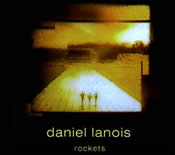
Since his pioneering work with Brian Eno in the early 1980s, Daniel Lanois has been of the most influential producers in popular music. His production credits include: U2’s The Unforgettable Fire, The Joshua Tree, Achtung Baby, and All That You Can’t Leave Behind; Peter Gabriel’s So and Us; The Neville Brothers’ Yellow Moon; Willie Nelson’s Teatro;Emmylou Harris’s Wrecking Ball; and Bob Dylan’s Oh Mercy and Time Out Of Mind. Lanois has also made four albums of his own: Acadie, For the Beauty of Wynona, Shine, and Rockets. [see discography]1
Born in Quebec, Lanois began his career in Hamilton, Ontario, where Brian Eno famously sought out his studio. For many years, he ran Kingsway Studio in New Orleans, while making records in Ireland, France, and California with U2, Gabriel, and Nelson. Lanois now lives and works in several locations—among them, Los Angeles—and continues to produce, compose, record, and perform live. We begin the interview with questions about these places, and about what impact place in general has had on his work. Having chosen locations for living and music-making carefully, Lanois makes an interesting case in today’s often homogenized, multi-national rock music scene: the same musical qualities that transcend the local have often been inspired by intensely regional music cultures. In particular, we try to probe connections between the Acadian traditions he grew up with and the Southern vernacular styles he has often worked with.
Lanois’s latest musical preoccupation has been with the pedal steel guitar. He is working on an album of solo unaccompanied tunes on the instrument, and our interview was an excellent occasion to learn about him as a composer and instrumentalist. His interest in the pedal steel also resonates with certain qualities of his production sound, what writers and critics have called “atmospheric,” “ethereal,” “melancholic,” and “spiritual.” We were lucky to be given a performance of some of his new pedal steel tunes in his recording studio in the basement of his Los Angeles home, which we recorded and include in the interview as streaming sound clips.
The pedal steel brings us to a discussion of the 1950s pop duo Santo & Johnny and early rock and roll. For Lanois, the focus of popular music has changed over the past fifty years from live performance (and the documentation thereof) to recordings that stand on their own. Nonetheless, in a typically postmodern spirit, Lanois has simulated the aesthetic of older recordings—accidental distortion replicated by effects and filters. The rest of the interview mainly concerns Lanois’s personal style as a producer and as an artist. Through the use of certain “tools” and a particular approach to the production, he has built (at least the reputation for) a signature “sound.” While Lanois questions this kind of consistency in his work, his comments on production and composition nonetheless reveal bases for consistent sonic elements.
Popular music producers do not get the press that the “artists” they produce do; but they make choices that are as “artistic” as those who play or sing. Like studying other famous producers such as Phil Spector, Giorgio Moroder, and Quincy Jones, looking at Lanois’s work teaches us more than studying just one artist. His work can tell us about the history of rock music in over the past two decades; beyond individual idiosyncrasies like Peter Gabriel’s vocal timbre or U2’s political agenda, Daniel Lanois gives us hints toward common aesthetic qualities of a range of artists. As a producer of his own music and of others’, he has had an enormous effect on the development and definition of genres within popular music: his vision of meaning and depth in music has rubbed off on a generation’s worth of rock recordings.

Jonathan Greenberg: How do you like living in Los Angeles?
Daniel Lanois: I don’t really live here. I spend most of my time in Canada and Jamaica, so I’m only just passing through here. I like it a lot. I think it’s a great city, great crossroads—always something going on. It’s much like other cities that I’ve been in [in that respect].
JG: You had your studio in New Orleans for a long time. What did you get out of New Orleans musically? Was there new music to discover there?
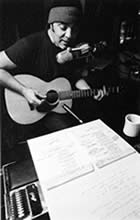
DL: You know, New Orleans is fantastic. I made a great Bob Dylan record there called O Mercy[listen], my first record [with him], and a Neville Brothers record called Yellow Moon. One thing for sure is that a lot of the great musicians come from the South. And for a Canadian kid to go down there and be exposed to the rhythms, the bass lines, the piano playing, it was really a great education. I met Brian Blade there, a really great drummer. I still work with Brian. We’re doing some shows this summer. We’re gonna do three shows with Dave Matthews in Florida: big places, big stadiums. Should be cool.
JG: Did you [as a French-speaking Canadian] feel any particular kinship being in a historically francophone area like New Orleans?
DL: A little bit. I might have felt more of a connection with some of the rural people, the Cajun community. But it was architecturally very much what you talk about, Spanish and French. You can still see all the influence there …
JG: So, you’ve recorded all over North America, and you’ve worked in Europe: does where you are when you’re recording an album, when you’re writing songs—what effect does that have on the music that you make?
DL: In Jamaica, where I have my cottage, it’s a small town, and there’s not a whole lot of music there other than church music, singing groups. It’s not a crossroads for popular culture. On occasion, there’ll be a street festival, and that’s where you get to hear a lot of music. They still like their big PA systems down there … In New Orleans and Jamaica and these more out of the way places music is about celebration, and they just kind of set it up any old place and start. You drive in Jamaica, and somebody will just set up a PA on the roadside next to a little coconut stand, and you go, “What is this about?” and then at night people are dancing—it’s lovely. And the same thing with the rural part of Louisiana, in the Cajun community. The music actually has a function there. You know, you want to dance on the weekend. So it serves the community. And that’s lovely. It’s nice to see there are still pockets of that.
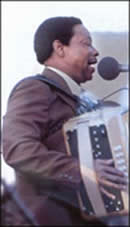
JG: Would you play with these people, like in Jamaica?
DL: In New Orleans, I played with a lot of bands there. In fact there was a great zydeco band—a guy named Rockin’ Dopsie, though he’s not around anymore—and I used to go and hear him at a little club called the Maple Leaf. I got to meet him, and I invited him to play on Bob Dylan’s record, O Mercy.
JG: I ask that because we can hear that influence on some of the records that you made in New Orleans. Your first solo album—one of the greatest things about it is that it’s called Acadie and here you were absorbing Louisiana culture, and in the album you hear these cultures trying to meet.
DL: I suppose there was a retracement of ancestral footsteps [on Acadie.] The Cajuns are originally from Canada. I just felt some kind of an itch to go down there and see what it was it was all about. And I was able to make some kind of a musical connection between the Cajun community and myself. As a record maker, I was interested in what the Neville Brothers were up to, and trying to get into the neighborhoods there.
JG: We’ve been talking a lot about the influence of place on your music, yet there’s a tension in your music between a sense of place and something that transcends that sense of place. Your studio—wherever it is—is going to have a sound that goes beyond where you are. You have this clear fingerprint on what you do that people talk a lot about.
[DL is playing recordings of him playing pedal steel during the interview.]
DL: Did you hear it on that steel guitar just now?
JG: Yes.
DL: I don’t know what it is or where it comes from, because these little steel guitar recordings—they don’t have any production on them. It’s just a guitar. People talk about my sound, but I’m just playing one instrument here—it’s not much of a sound.
JG: How can you not have any production? If there’s a microphone, you’re choosing what microphone to use …
DL: Point being, that [recording] was essentially a documentation of playing that happened in the moment—it was a two-track recording. I suppose the thing that has served me best has been the ability to spot a little bit of something special at a given moment and say, OK that’s it right there. Let’s concentrate on what is glaringly special at the moment and make something out of it. And I still operate with that criteria. If I hear something that I think resonates true, then I just beam in on it and say, that’s it, and not try and incorporate too much.
Olivia Mather: You spoke before about ancestral influences on your music and I wanted to ask you about that. When did you know that you wanted to be a musician? Was that something that you ever came to a self-conscious decision about?
DL: I knew pretty early on that I was driven by music, from when I was about ten or eleven. But when I was fourteen was when I decided to do it as a living. I didn’t grow up with my dad, so I went out with my uncle on a rowboat—he was a very nice guy—and I said to him that I was thinking of not bothering with school and just carrying on with the music. I asked him if he thought that was a good idea, and he said, “Yeah, just follow your own heart.”
OM: You have a lot of family members that were fiddle players. Could you talk a little about that?
DL: They were called violoneux, which is a French term for fiddler. My grandfather and my dad were violoneux. And on my mom’s side we had a lot of singers. They just sang traditional French Canadian folk songs, which were just really about weekend entertainment, not unlike the Cajun communities—“We work hard all week, it’s the weekend, let’s have some fun”—self-entertainment society. So the violins would come out, and there’d be some tap dancing, and singing these old folk songs. When you have that around you when you’re a little kid, that’s great. You actually get a chance to hear something real, rather than somebody playing you records of something real. It’s just a pure form to be exposed to. I imagine it’d be like if one of your parents or a friend of the family was a really great storyteller and just made up a bunch of stuff. That might actually be a greater experience than going through the normal classics that every kid would read. So it’s the difference between reality and study.
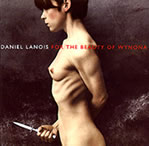
OM: When I heard the song “The Collection of Marie Claire” from For the Beauty of Wynona it reminded me of the Appalachian fiddle tunes that are played in unison with singing. You do that when you start to sing—play in unison with what you’re singing. I assumed that the strain that was influencing you was the French Canadian tradition, but you don’t actually use fiddle on either Wynona or Acadie.
DL: Me playing in unison with singing or harmonizing with my singing is just a thing that I developed a long time ago to help me stay on track. Because I’m not a really powerful singer, I use the guitar almost like a second singer. So I never just strum through songs, I actually play a harmony to a singing melody, and I get a better support system that way. But the driving force of that tune was the story. I wrote a lot of songs about the mixture of cultures—French culture, English culture, or rural culture and urban culture—and that one was about the mixture of rural and urban. It’s about a guy coming from the woods and visiting Montreal and being wowed by the city lights and stumbling into a striptease parlor and falling in love with this girl. I was touched by the waste of love in cities, how somebody’s efforts could never be considered in the presence of these parameters, even though their heart might be entirely true. And it’s probably still going on, [even] right here in Los Angeles. The kindest person will be the loneliest … It was also influenced by a story called “The Collector” [by novelist John Fowles]. In it, a butterfly collector falls in love with a girl and she’s oblivious to his bouts and then he abducts her in the end. So it’s a story about love and abduction. And that’s what “The Collection of Marie Claire” is about.
JG: There wasn’t any fiddle on either of those albums.
DL: I’ve never used fiddle on a record, I don’t think. I like fiddle and I use fiddle melodies, but I’ve never quite stepped into it.
JG: It seems a little ironic in the end that a record called Acadiehad no fiddle on it.
DL: Well, I guess I didn’t want other people playing on the record too much. So I did my own playing. Some of the drumming I didn’t do. I’ve always maintained that it’s best if most of the music comes from the artist rather than employing superimposition.
OM: I was wondering what you thought of the recent growing interest in folk music, especially since the release of the movie O Brother, Where Art Thou? I know you haven’t directly been involved, except maybe through Emmylou Harris.
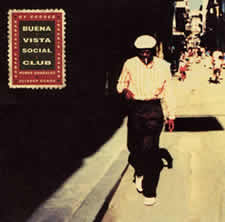
DL: It’s not unlike what happened with Buena Vista Social Club. I believe that a large percentage of the community likes quality. We find ourselves dragging our way through a lot of popular culture at any given time—it’s just the way it is—and certain things just get all the attention, and you look at it, and say, “Why is this getting all the attention?” Well, nobody really knows, other than it’s popular. And then somebody will bring a project around like Buena Vista Social Club and it’s just beautiful music with a great bedrock of tradition, fantastic melodies, virtuosity and not about attitude, or what people are wearing, or who they’re fucking. It’s just the music. Then you get sort of a collective synchronicity kicking into place saying “We’ve had enough with the tabloid—we just want a nice record to listen to.” So that’s why these things become popular. So I think that’s what happens in the case of that great bluegrass music.
OM: We had an article about two or three issues ago in our journal about country music and what the author called the “O Brother aesthetic” in production. He says that Emmylou Harris’ album Wrecking Ball was influential for the way T-Bone Burnett acoustically framed some of the songs for the soundtrack of O Brother. And on Gillian Welch’s first album, Revival since Emmylou’s song “Orphan Girl” on Wrecking Ball came out first. One thing that always struck me about Revival was that even though there were usually two instruments and two singers per track and that there was an amazing amount of acoustical space, especially on [Welch’s version of] “Orphan Girl.” Another example of this would be “Didn’t Leave Nobody But the Baby,” from O Brotherwhere there’s kind of a musical-saw-type sound in the background that really gives a nice sense of space to it. To me it seems like something that T-Bone Burnett is picking up from some of your production style.
DL: Oh, well that’s a nice compliment, I never thought about it. Without any doubt, if you do good work and people like it it’s gonna maybe influence somebody: they’re gonna say, “Wow, look at Lanois—who would have thought? He pulled this off pretty good, and people seem to like it, so let’s start with that and go to another place.” That’s actually the meaning of folk music. If you can unveil the stereotype for a minute, the folk tradition is the passing on of information. It’s as simple as that. It’s like I’ll sing something this way, you hear it, you’ll like it; you’ll whisper it to him, and he goes to the club and does a rendition that in fact is a little different. And that’s—we’ve built careers on it. We all learn something because of it. So, if there’s a few shades of my efforts turning up in T-Bone’s work, then I’ll take that as a compliment.
OM: We wanted to talk about pedal steel a little bit. You said that the recording you were just playing for us is something that you’re working on now. We know that you were really influenced by the pedal steel guitar in the Santo & Johnny records from the late 50s. How did you get into them?
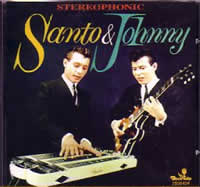
DL: Santo & Johnny. Well, you know, “Sleepwalk” was a hit [in 1958] when I was a little kid. There was a lovely thing happening in that time: the weekend dance. Kids would get together and really look forward to the weekend dance. They’d play sexy slow songs that were often in the 6/8 time, you know[sings] and you got a chance to dance cheek to cheek and maybe on a hot sweaty night … so I always liked that part of rock and roll culture. When people think of rock and roll they usually think of up-tempo and fast rhythms, but there was a lot of really slow sexy stuff back then that still appeals to me today. And for that matter, the fast rock and roll was not that fast—it had a lot of roll in it. You listen to[sings]: “keepa knockin’ but you can’t come in, come back tomorrow and try again.” It’s not fast, you know. And then something happened in the 70s where suddently it all became eighth notes [sings]: do do do do do—and it lost a lot of sexuality, and so i keep going back to those early Santo & Johnny [records]. I have the steel right here, you wanna see it?
[Lanois leads us downstairs to his basement recording studio, where he plays his pedal steel guitar]
DL: I still have my original ones, my original steel here, that I used on that track called “Deep Blue Day” [with Brian Eno] they used in Trainspotting [plays].
DL: This section is what I call the “Samuel Barber” section [plays].
DL: I call that “Panorama.” This one is more melodic, [it’s] called “Thank You” [plays].
DL: I’ve been working on playing up really high. Most players don’t play really high. I like this kind of raindrop sound [demonstrates]. So that’s it. I play it as often as I can.
OM: Besides Santo & Johnny, who are the other steel players that you listen to or feel that you’ve been influenced by?
DL: I was into David Lindley in the 70s, who used to play with Jackson Browne. Real good. He’s a straight slide player, he’s not a pedal player. I always liked the passion in his playing. And then I was a fan of Ry Cooder’s Paris, Texas soundtrack. It was an influence on me. Again, no pedals—Ry plays just straight-up slide. There was a guy in my neighborhood when I when I was growing up, Bob Lucier. He was my teacher and he used to play in country & western bands around the neighborhood. And in Toronto at the time the strip was really happening, Yonge Street, a great crossroads of all kind of music. There was a great blues club, and everybody went through there, including Muddy Waters. Then there was an R&B club where I got to hear James Brown, Wilson Pickett, all the best soul artists—Sam & Dave—all the best soul artists of the time. And I used to play at the club called Brown Derby. I was just a kid—I was like 15 years old—and I was in a show band. It wasn’t much of anything, we just used to do like show music, you know. But what was important about it was these other clubs that were on just the next block, so we played a lot of sets, six or seven, and in between I would run to other places and hear the other bands, and then come back for my next set. So it was a cool hang, and I got to hear some of the greats of that era, just from playing on the strip. It was kind of the last of that era, and a couple of years after that it all disintegrated …
JG: What years was this?
DL: This would have been like late 60s. It’s how I imagine the strip here in Los Angeles would have been around the same era: Little Bobby Darin would be there, and the Stones were hanging out, and it was not sort of an embarrassment of tourism as it is currently. Last night I was hanging out with my buddy Robbie Robertson, who is a generation ahead of me, and he really remembers that time, you know, traveling and playing with Ronnie Hawkins. Back then it wasn’t so much about making records, it was about playing, and records were a by-product of an already existing live performance ensemble. And that was the meaning of the word “record”: “Let’s document something that’s going on.” In our contemporary times, bands get put together with the view, “We’re gonna get a record deal, we gotta get a publishing deal, we gotta get everything worked out, and once we got everything worked out, then we will play.” So, it’s just like a mirroring of what we talked about earlier, the self-entertainment society that has music out of necessity. It loves music, needs music, and it’s gonna have music absent of any industry. So I still have a soft spot for that thought, that romantic notion.
JG: It’s funny though, that you, of all people, have romanticized that kind of live music culture, when you have made much of your living as a record producer.
DL: Yeah, yeah. It’s a contradiction for sure.
OM: And the way you use sounds that are difficult to produce live.
DL: Yeah, well you know Jimi Hendrix used to say the same thing: “That was a recording, and this is live.” By the time I came into the picture, the studio was not a place of documentation anymore. It was like, OK, you’ve heard all those great inventive British recordings, the Beach Boys stacking up harmonies; and it’s like wow,
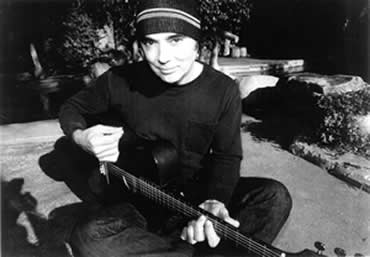
all these possibilities were available to us. So, for me to be a documentary recordist at my time, I would have been, like, way backwards. So I just chose to go with the new frontier. I wanted to be an innovator. I was hanging out with Brian Eno, and it was all about pushing the boundaries. Interfacing—in school you’re taught that this goes here, then you plug it into that, then over here, and that’s the way it is. And you challenge conventional interface and that’s when you start stumbling onto the cool sounds. It’s like, “OK, we’ll take this thing that’s normally the last thing in the chain and put it in the front,” and so on. So by monkeying around with the rules, myself and Brian Eno were able to hit on some pretty cool stuff.
JG: … which then went right back into that live music culture. When those bands that you guys were producing had made a record, they then used a lot of that stuff when they went out on tour. I remember seeing Peter Gabriel on his Us tour around ‘92 before I’d heard the record. But it was obvious that what he was doing in this big stadium, wherever he was playing, had some amazing production effects that he would have never thought of without the record.
DL: Well, yeah. Folk music. I’ve seen that on the U2 shows. They took it to a whole other level where they would actually take things from the record, like, they’re just like little sounds that are kind of cool and signatures on the record. At their shows they have a whole sort of city under the stage of people doing things. I’d say probably eighty percent of their set is to fixed time, allowing them to play the same tempos as the record and therefore pull some of the sounds off the record. I mean, the Edge, [U2’s guitarist, who often plays multiple guitar tracks on a single recording] bless his heart, is covering ninety percent of it. He’s only one guy up there, we gotta give him a break. So some of the Eno-sonics or whatever are always kind of on a computer down in the underbelly of the operation.
JG: And that’s not a bad thing.
DL: That’s show business. That’s OK.
OM: You’ve mentioned in other interviews that you’ve got a paint box of production tools, and that any artist who comes to you to work on a record has access to your whole palette of influences and sounds. How would you describe that tool box? What is in it?
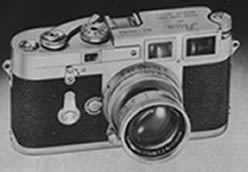
DL: Well at any given time I’m excited about some tools. Currently my pedal steel guitar playing is pretty up there, so that would be one of the ingredients. And I’m never that thrilled about too many ingredients, it’s usually three or four, where I’m really focused and I understand. Aside from what I’m currently excited about, I try and keep a lot of my past tools that I’ve used, I keep them around and lubricated. They’re just classics. If you want a harmonium sound, if you like that sound, then there’s no substitute: it’s like a little pump organ, it has a beautiful sound, and it never goes out of fashion. And if you want that sound, then you have to have it, or else you gotta rent it, and you may not get a good one. So part of the responsibility is to hang onto the tools that have served me well, and just say, “OK, that’s for that sound, it only has two sounds.” And the same thing goes with microphones—certain microphones just have a certain sound, and that’s that It’s kind of like a lens, you know. You want a nice twenty millimeter Leica from the early 60s? You’re not gonna run to Good Guys and hope to find it. Instruments, amplifiers, microphones—those are all pretty important to me. Funny enough, the recording medium I think is less important to the personality of a record. Over the years I’ve used whatever medium is available at that time. I first started just a two-track recorder, and then every step of the ladder up to twenty-four-track; then I moved into digital. Currently I use a Canadian digital machine and I still have my analog machines. But the medium—that’s almost like talking about what kind of film you like to use. What’s probably more important is your lighting, your subject, what kind of lens you’re using, how big your format is.
JG: And your ideas, right?
DL: Exactly. You’re gonna hang from the ceiling with two tennis balls. OK, that’s that shot. So people talk about the medium a lot, like it’s the most important thing. It’s about the ideas and the vision and who’s in the room and what you’re gonna do. That’s probably the most important thing. But you know, whenever I can, I keep the tools that have served me well.
OM: So ultimately it’s about good players, good instruments, and good songs.
DL: Yeah, it’s that, but it’s also what is unfolding at the moment. Some of the things I’ve done very well didn’t start out as songs. They started out as people playing together, and something would erupt, and it would conjure up some kind of an image. Like I stopped in Dublin before Christmas to work with U2 for a week on their new record [How to Dismantle an Atomic Bomb], just to help them out a bit. They were having a little bit of trouble with the beginning of one song, and I said “Just abandon what you’ve got and let’s play it again.” So we just huddled up on the couch—myself, the Edge, Bono, Adam—and we just had a little clicker in the headphones because Larry was going to overdub his drums after. And we just
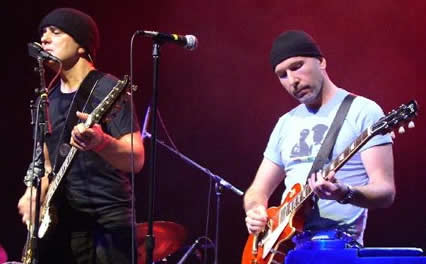
said, “OK, let’s play the whole song up to this point, and we’ll just recreate a whole new beginning.” And we did, and it started having this sound, and I said, “You know it’s kind of like windshield wipers in the rain, door opening, and looking off into the distance,” and it almost became like a cinematic moment. You couldn’t explain how it happened, or how it got there, or what you plugged into what—it’s just what happened, it’s just the image of that recording. We edited that to the main body of the song that they had already put a lot of work into … And it was magic.
JG: You do a lot of what we do as musicologists, which is to analyze the music and talk to the band and help them make sense of what’s already going on so that they can fit the last piece in.
DL: You talk about it after. What often happens in my little world is I’ll see a possibility and it’s just on the edge of taking place. And I’ll just kind of push it that way [gestures]. It becomes a game of psychology at a certain point, and you want to trick people into a situation. Sometimes they know they’re being tricked, and that’s good. It’s like telling the same story again and you added some embellishment, and everybody in the room keeps quiet about it, because they know you’re lying—maybe there’s one newcomer, and that’s enough to go on.
OM: You’re also known for being a meticulous producer in terms of documenting, actually writing down some of the things that you do. There were three thoughts I had about your notebooks: maybe you kept them for posterity, or perhaps it was your own way of working things out through your own notes, or maybe it was like the results of a chemistry experiment.
DL: I use these big books, and I’ll show you [he shows us his notebook]. I start with a graph, and then, if I have an idea—the windshield wipers in the rain, dark night, slow tempo, landscape, humble beginning, story-telling very much at the forefront of this idea—that goes in the box. Then the next box will the be for the next day, maybe the arrangement of the same song, a description of each section and so on. And so you actually write down useful information. Then maybe at dinner time, let’s make a list of our favorite titles so far. And then in about three or four days that page will be full of information that’s relevant to the project. And then glancing at that one page, you’d be surprised at how much inspiration you can get and reminders of what people said. And so it becomes like a personal menu or journal relating to that project without preconception. Not something that I wrote before I got there, it was written during the process. I find that these writings become the personality of that project; it’s almost like paying respect to that project.
JG: When we read that you kept these notebooks, we were thinking, wouldn’t it be great to get these published and read through them?
OM: This is what musicologists dream about.
DL: One of them is in the Rock and Roll Hall of Fame. I’ve got to get it back, they’ve had it for a couple of years.
JG: Well, someday, there’s a market for it. People who like this music—scholars at least, but fans, too—would love to see how this stuff was dreamt up.
DL: I have a lot of extensive notes from the 80s. And a lot of the struggles I was going through are all in there. Not particularly about the people I was working with, but about myself.
JG: Do you go back and look at those old notebooks?
DL: I’ve looked at them and they’re quite touching. What’s touching about them is the amount of dedication and arrogance. I don’t mean arrogance in a negative manner, just sort of the arrogance of concentration, having made a decision to not be distracted by anything other than the work. I’m not saying I was right, but that’s definitely where I was at. Just the dedication, the commitment. There’s so much dedication and commitment in my work and in those writings of that time, that I’m aware of the fact that I was probably like an emotional midget in other areas. It was completely out of balance. Still looking for balance.
JG: You’ve said you’ve always written music, always composed music even before you had made your own solo records. Do you think you came at it from the point of view of a producer? When you conceptualize songs, when you first think of a song, do you think about how you want it to sound in a fuller sonic sense?
DL: I can do that now, I could not do that then. Because now I have so much technique. Like that track “Deep Blue Day” which I mentioned that shows up in that Trainspotting movie. OK, “Deep Blue Day,” I know how to make that, we could do version two. Back then, it was all discovering. So, I still like to make the discoveries. That’s probably the most fun. But if you said to me, “I really like this kind of a feel,” and you played me something I’ve done before, I would remember how to do it, and could probably do it again.
JG: When you write a song, what’s the process? Do you start with lyrics, chord progressions, how does it go?
DL: Sometimes it’s just melody and then I fill in the melody with words or maybe a catch phrase—melody has a pretty big role. And there are times when I just write words and then I apply music to the words after that. That can be good, too. But I keep an “orphanage” and I have one of these little mini-disc recorders and I hammer out ideas in there. And the best ones usually come after coffee first thing in the morning. There’ll be like a string of about twenty of them. And maybe there’ll be half a dozen that are special. And it’s those little—I call them seeds—it’s those seeds that will ultimately become songs.
OM: What are the sources of inspiration for your lyrics?
DL: Usually, personal experience. A title. Sometimes I’ve been influenced by film. I have a song on my first record called “Ice” which was influenced by a movie [Track 16] about a guy who loves his girlfriend so much he kills her by the riverside. So there have been times when I’ve really been influenced by film and by already existing stories. I was staying at a friend of mine’s apartment in New York, and she was a famous folk singer in the 60s, and so she had stacks of old songbooks. I was just kind of glancing through them and I saw a tiny piece of lyric that said “Silium’s Hill.” And so I wrote a song called “Silium’s Hill” not knowing anything about what it was.
JG: I noticed that on your second solo album, there were at least a few tracks where your voice had been put through an effect.
DL: Oh yeah, I was kind of going through a bad time on my second record vocally. It was a very strenuous time for me, and so it sounds strained a bit on the record.
JG: But there is some kind of effect there, no?
DL: It’s probably just distortion.
JG: You’ve done that with other bands too.
DL: Yeah. With Bono on Achtung Baby.
JG: But it’s always interesting to me when somebody uses distortion on the voice, because the voice is such a personal thing. It’s not like distorting a guitar, which is already an electronic signal. Distorting the voice seems like a pretty heavy decision.
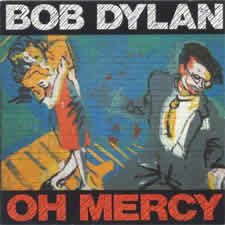
DL: If you study your rock and roll recordings of the 50s, there’s a lot of overdrive going on, because the medium up to that point had been largely about miking things from a distance. You wouldn’t put a microphone right on a horn or somebody’s face. So, when rock and roll came along, it was louder than anything that had happened before, and the microphones and the preamps were overloading. You hear those old Little Richard recordings—they’re distorted, and it’s part of the greatness of them [listen]. And when I worked with Dylan, he said “I like the sound of records from the 50s. Why can’t we get that today?” And I didn’t know how to answer that, and I listened to them. He gave me a list of records he liked and I checked them out, and sure enough they were all kind of fucked up and distorted. And I wanted to make sure that he had access to those colors, and I found a way of mixing the very high fidelity with overdrive.
JG: In a way that sounds a little different from the 50s.
DL: Yes, it could never be the same. And there’s a lovely sense of depth of field on that record, and that was [done] in an old fashioned way. Just have a lot of people in the room. Somebody sitting further back, and they sound further back—the opposite of isolating then recreating space with mixing. Natural depth of field is a lovely thing. It’s comforting. As humans we like it, we see it every day—just looking out a window. It’s not a fabrication of depth—it’s real depth. And when we’re exposed to real depth in a record, I think we find comfort in it.
JG: You’re saying that one of the ways you achieved that was by putting lots of people in the room?
DL: Yeah. Just the way things sound naturally in a room. I mean, you already hear the beginnings of messing with depth of field in old John Lee Hooker recordings where his amp will have all kind of reverb in it, but his voice will be bone dry and then you can hear his foot, you know? Playing with depth like that is really exciting to me. And I think, when you get people in a room, you’re suddenly presented with a challenge and lots of possibilities—how I imagine it would be like being a lighting director. You’re presented with a scene that has a hundred characters instead of four, and it’s like, “God, how are we going to deal with this situation?” And at the moment, your resourcefulness kicks in and your past experience. When you’ve had all that experience, you’re like a cat: you fall on your feet no matter what’s thrown at you. And it’s nice to challenge a master. It’s good to insult a master, and say, “OK, you think you’re good, well, we’ve got a hundred more people here than what you thought we were going to have, and we want them lit, and we’re shooting in twenty minutes.”
JG: I like that idea—it’s like you’re trying to get the listener to experience that space. Recordings are often put in opposition to live recording, because [a] recording could have been made anywhere on earth at any time and we don’t know where it is. But that anonymity is what you’re trying to break through—you’re trying to get the listener to experience that space itself—to be able to put themselves a little bit in that room.
OM: Music writers seem to use some similar words over and over again about your music and productions. What do you think of “melancholy,” “spiritual,” and “searching”?
DL: A friend of mine said, “The searching thing, that’s good. Because if you stop searching, then you won’t be innovating any more.” So, I’ll take it as a compliment.
OM: What about “haunted” and “extraterrestrial”?
DL: Yeah, more compliments. “Out of body” is one I like to use these days, which is like being a channeler for a minute, staying outside your ego and receiving some kind of signal or information. There’s something beautiful about that—if that happens to come to you and you’re able to get it on a recording, you could actually say, “I’m not responsible, it was just something that I felt.” Which is a nice thing, because, again, it operates outside of vanity, outside of ego and braggartry.
JG: How wide ranging are your listening habits?
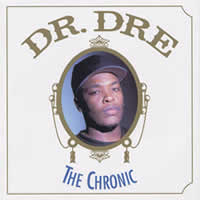
DL: Very wide. A lot of my listening is chance listening, just in people’s houses. A friend of mine has a clothing store and I hear some tracks in there. I like going to bars that have really good juke boxes for that reason—it rocks my world for an evening. In a way, it’s a very luxurious time because we can look at the history of music and influences and we get to be a genius at choosing. It’s like, well, that’s the best track from ’82. That’s why DJ’s are kind of the contemporary heroes, because all they need is a record collection, and if they’ve got good taste, and put time in, they get to show everybody else who’s busy doing other stuff that they’ve picked some really cool records. So it’s really a great time in regards to studying what fifty years of rock and roll has had to offer—you just hand pick the best cherries. And I never get tired of really good retro radio. If somebody plays me an old track that brings me on my knees, I think, thank you—it’s like food for me. But I feel the same way about contemporary music, anything that’s great, you know. Even though I don’t play the record all the way through, there’s a couple things on the Destiny’s Child record that I think are technological giants. Some of Dre’s grooves, are like, “Wow, don’t know how you did it.”
other stuff that they’ve picked some really cool records. So it’s really a great time in regards to studying what fifty years of rock and roll has had to offer—you just hand pick the best cherries. And I never get tired of really good retro radio. If somebody plays me an old track that brings me on my knees, I think, thank you—it’s like food for me. But I feel the same way about contemporary music, anything that’s great, you know. Even though I don’t play the record all the way through, there’s a couple things on the Destiny’s Child record that I think are technological giants. Some of Dre’s grooves, are like, “Wow, don’t know how you did it.”
OM: Where do you see your own work going now?
DL: I’m going to do this pedal steel music. And I have so much stacked up material. Great psychedelic stuff from Mexico. So I’m probably going to put out a pedal steel guitar record, and then following that I’ll put out a more tripped-out, psychedelic, really peyote record.
JG: It’s funny how, when you play the pedal steel, the way that you are hunched over the instrument. I kept thinking, that’s unusual for rock music. Because often, even with a keyboard player, they’re a little bit more upright. Guitarists—you can see their whole body. And here you are at the pedal steel and you’re like a mechanic. It’s like you’re at the mixing board.
DL: I’m working on a stand-up model, so don’t worry. I just haven’t gotten the legs long enough yet. I don’t go for the hunched over thing in motorcycles, and I don’t like it in music either. I’m just a victim of design here for a minute. Don’t worry, I’m coming up with my stand-up model.
JG: You know, I kind of liked it. It was like the genius working at his instrument. It taps into a cerebral quality in your music.
OM: Referring to the train sounds at the end of “The Collection of Marie Claire” you said in an interview, “I try and promote as much strangeness as possible because I think that’s what makes records interesting in the end.” How does a rock and roll aesthetic—a live aesthetic—work with the whole idea of strangeness? Are those different things? Or is there a priority there?
DL: I suppose the contradictions that happen—for example, we’re all looking for inner peace, tranquility, and a large population is carrying a yoga mat around—but we put up with sirens and dogs barking and leaf-blowers: we tolerate an awful lot in an urban environment passively, and we try and balance that out with the readings and the prayers and the meditations and so on. When I see those kind of contradictions it sort of appeals to me, that we still have the beauty of the church bell, or the romantic sound of a train, and then that would all be insulted by so many other things. In fact, I have a track called “Sirens” that I’d like to play for you one day that is about that. It’s beautiful, and then as it evolves, there’s more and more contradiction, the metal ripping, and plastic burning. It’s just like it’s disintegrating into ashes, but the beautiful melody keeps playing, almost like the sinking of the Titanic. So, it’s nice to mix. I think great art has always had contradiction in it. The peacefulness of that Hopper painting, “Nighthawks”: the tranquility of that image and the reassurance of
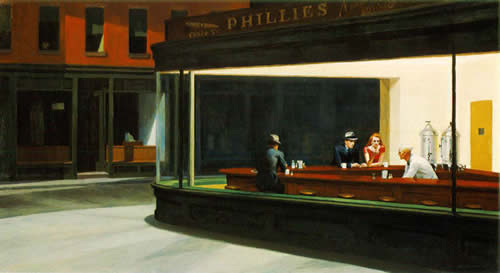
opulence and there’s so much confidence and so much wealth in this culture, and yet the people at the bar are lonely. And so, the loneliness sort of intercepts the seemingly stable parts of the painting. The last supper will have betrayal hidden in there somewhere, and so on. So I think that if you can get that in music, it’s a cool thing.
Discography
Buckley, Jeff. Grace. Columbia CK-57528, 1994.
Buena Vista Social Club. Buena Vista Social Club. Nonesuch 79478-2, 1997.
Cooder, Ry. Paris, Texas: Original Motion Picture Soundtrack. Warner Brothers 9 25270-2, 1990.
Dylan, Bob. Oh Mercy. Columbia CK 45281, 1989.
Everly Brothers, The. Classic Everly Brothers. Bear Family BCD 15618-1—BCD 15618-3, 1992.
Gabriel, Peter. Us. Geffen GEFD 24473, 1992.
Harris, Emmylou. Wrecking Ball. Elektra 61854-2, 1995.
Lanois, Daniel. Acadie. Warner Brothers 9 25969-2, 1989.
———. For the Beauty of Wynona. Warner Brothers 9 45030-2, 1993.
———. Shine. Anti 86661-2, 2003.
Neville Brothers. Yellow Moon. A&M, 1989.
O Brother, Where Art Thou? Mercury 088 170-069-2, 2000.
Richard, Little. 22 Classic Cuts. Ace CDCH 195, 1986.
Rockin’ Dopsie. Saturday Night Zydeco. Maison de Soul MDS-104, 1988.
Santo & Johnny. “Sleepwalk.” Billboard Top Rock & Roll Hits: 1959. Rhino R2-70620, 1990.
Trainspotting: Music from the Motion Picture. Capitol CDP 7243 8 37190 2, 1996.
U2. The Joshua Tree. Island 7 90581-2, 1987.
———. Achtung Baby. Island 314-510 347-2, 1991.
———. How to Dismantle an Atomic Bomb. Interscope, 2004.
Welch, Gillian. Revival. Almo AMSD 80006, 1996.
Films
Buena Vista Social Club. Dir. Wem Wenders.Live/Artisan, 1998.
Track 16. Mick McCleery, 2001.
The Collector. Dir. William Wyler. Columbia, 1965.
Bibliography
Fowles, John. The Collector. Boston: Little, Brown and Company, 1963.
- Thank you to Caroline Sprinkel and Tanya Merchant for their help with this interview. ↩
